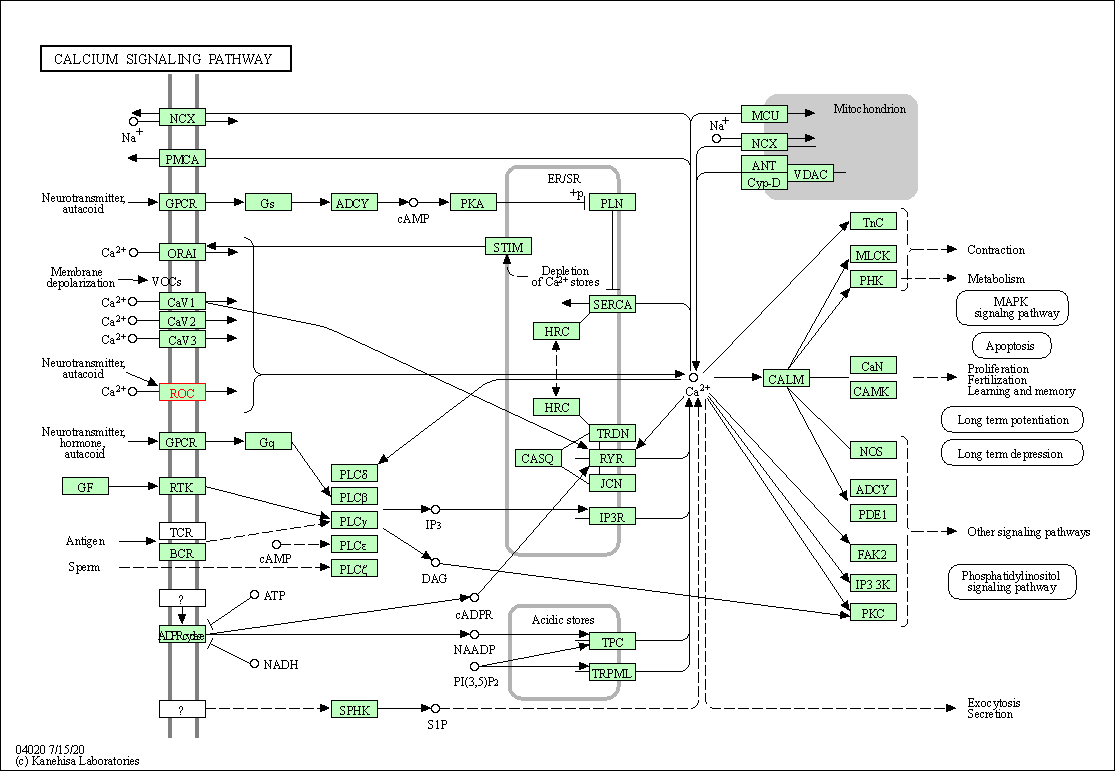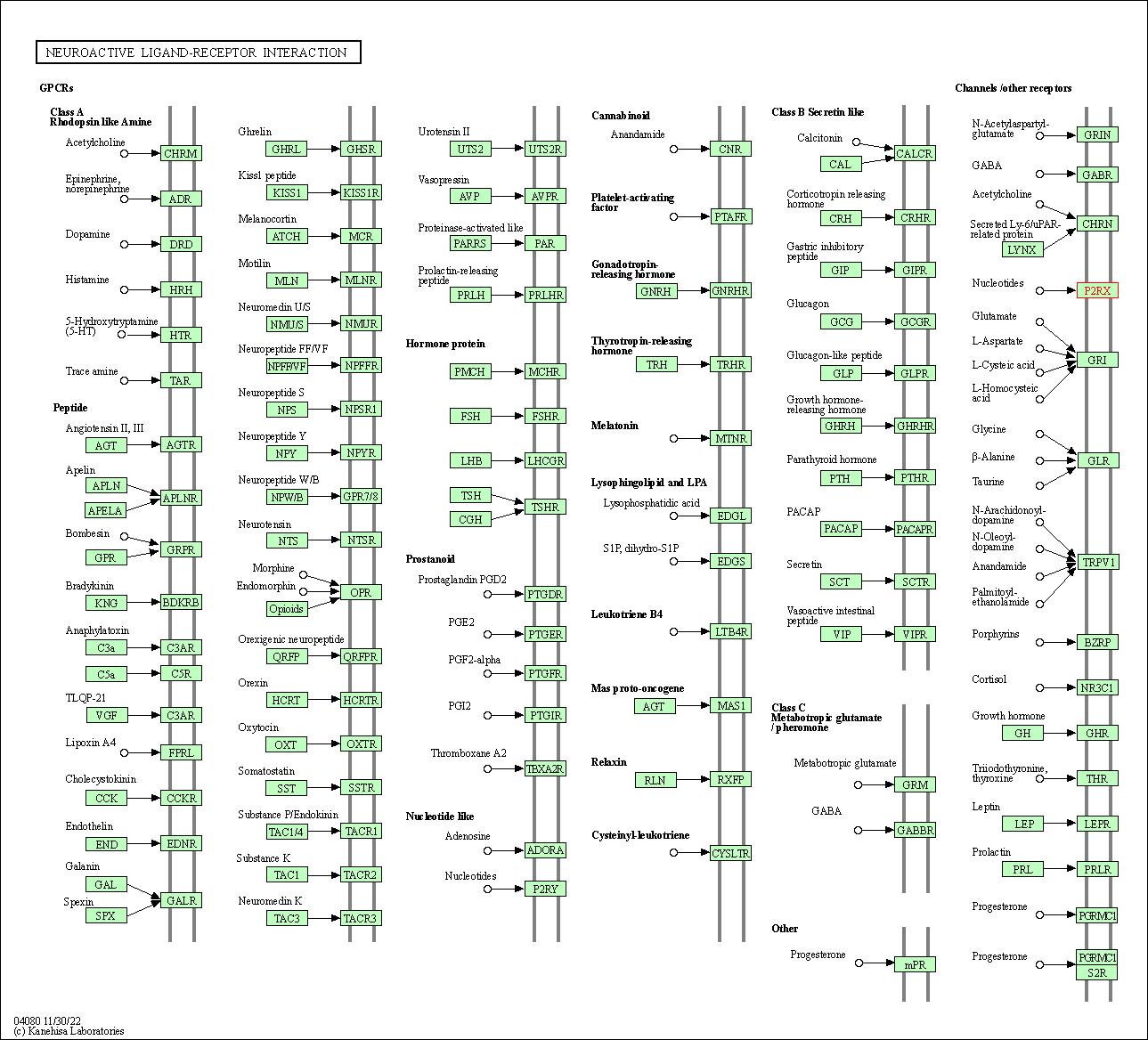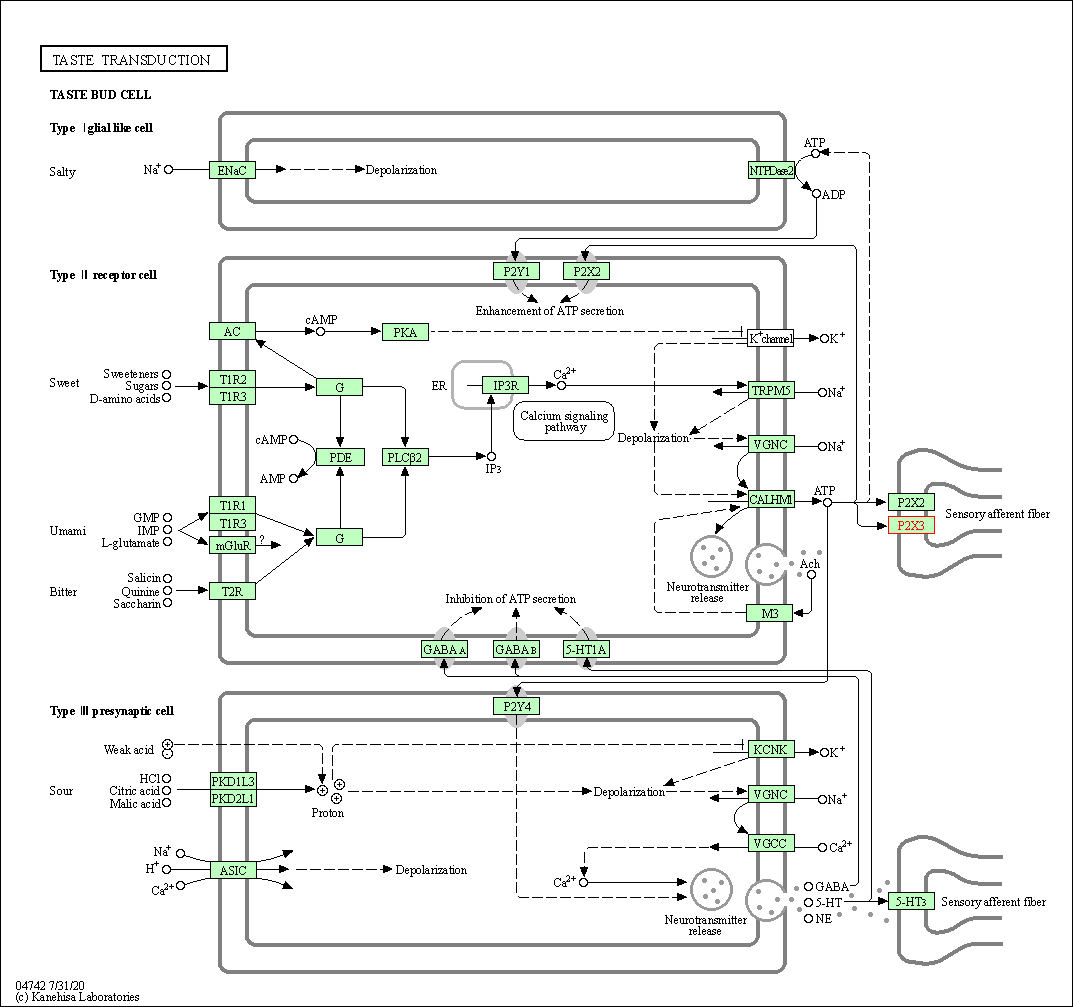Target Information
| Target General Information | Top | |||||
|---|---|---|---|---|---|---|
| Target ID |
T17140
(Former ID: TTDR00278)
|
|||||
| Target Name |
P2X purinoceptor 3 (P2RX3)
|
|||||
| Synonyms |
P2X3 receptor; P2X3; P2RX3; ATP-gated ion channel P2X(3)
Click to Show/Hide
|
|||||
| Gene Name |
P2RX3
|
|||||
| Target Type |
Clinical trial target
|
[1] | ||||
| Disease | [+] 1 Target-related Diseases | + | ||||
| 1 | Cough [ICD-11: MD12] | |||||
| Function |
Receptor for ATP that acts as a ligand-gated ionchannel.
Click to Show/Hide
|
|||||
| BioChemical Class |
ATP-gated P2X receptor cation channel
|
|||||
| UniProt ID | ||||||
| Sequence |
MNCISDFFTYETTKSVVVKSWTIGIINRVVQLLIISYFVGWVFLHEKAYQVRDTAIESSV
VTKVKGSGLYANRVMDVSDYVTPPQGTSVFVIITKMIVTENQMQGFCPESEEKYRCVSDS QCGPERLPGGGILTGRCVNYSSVLRTCEIQGWCPTEVDTVETPIMMEAENFTIFIKNSIR FPLFNFEKGNLLPNLTARDMKTCRFHPDKDPFCPILRVGDVVKFAGQDFAKLARTGGVLG IKIGWVCDLDKAWDQCIPKYSFTRLDSVSEKSSVSPGYNFRFAKYYKMENGSEYRTLLKA FGIRFDVLVYGNAGKFNIIPTIISSVAAFTSVGVGTVLCDIILLNFLKGADQYKAKKFEE VNETTLKIAALTNPVYPSDQTTAEKQSTDSGAFSIGH Click to Show/Hide
|
|||||
| 3D Structure | Click to Show 3D Structure of This Target | PDB | ||||
| HIT2.0 ID | T69HP8 | |||||
| Drugs and Modes of Action | Top | |||||
|---|---|---|---|---|---|---|
| Clinical Trial Drug(s) | [+] 6 Clinical Trial Drugs | + | ||||
| 1 | Gefapixant | Drug Info | Phase 3 | Cough | [1] | |
| 2 | BAY-1902607 | Drug Info | Phase 2 | Cough | [1] | |
| 3 | BAY 1902607 | Drug Info | Phase 1/2 | Cough | [2] | |
| 4 | AF-130 | Drug Info | Phase 1 | Hypertension | [3] | |
| 5 | BAY 1817080 | Drug Info | Phase 1 | Endometriosis | [4] | |
| 6 | BAY-1817080 | Drug Info | Phase 1 | Endometriosis | [1] | |
| Mode of Action | [+] 3 Modes of Action | + | ||||
| Inhibitor | [+] 10 Inhibitor drugs | + | ||||
| 1 | Gefapixant | Drug Info | [1] | |||
| 2 | BAY-1902607 | Drug Info | [1] | |||
| 3 | BAY-1817080 | Drug Info | [1] | |||
| 4 | AVVYPWT | Drug Info | [7] | |||
| 5 | Cyclic LVVYPWT | Drug Info | [7] | |||
| 6 | ISOPPADS | Drug Info | [9] | |||
| 7 | LAVYPWT | Drug Info | [7] | |||
| 8 | LVAYPWT | Drug Info | [7] | |||
| 9 | LVVAPWT | Drug Info | [7] | |||
| 10 | LVVYPWT | Drug Info | [7] | |||
| Antagonist | [+] 8 Antagonist drugs | + | ||||
| 1 | BAY 1902607 | Drug Info | [1] | |||
| 2 | AF-130 | Drug Info | [3] | |||
| 3 | BAY 1817080 | Drug Info | [5] | |||
| 4 | AF353 | Drug Info | [6] | |||
| 5 | MK-3901 | Drug Info | [8] | |||
| 6 | RO3 | Drug Info | [10] | |||
| 7 | TNP-ATP | Drug Info | [11] | |||
| 8 | [3H]A317491 | Drug Info | [12] | |||
| Agonist | [+] 1 Agonist drugs | + | ||||
| 1 | BzATP | Drug Info | [8] | |||
| Cell-based Target Expression Variations | Top | |||||
|---|---|---|---|---|---|---|
| Cell-based Target Expression Variations | ||||||
| Drug Binding Sites of Target | Top | |||||
|---|---|---|---|---|---|---|
| Ligand Name: Adenosine triphosphate | Ligand Info | |||||
| Structure Description | Crystal structure of the ATP-gated human P2X3 ion channel in the ATP-bound, open state | PDB:5SVK | ||||
| Method | X-ray diffraction | Resolution | 2.77 Å | Mutation | Yes | [13] |
| PDB Sequence |
FFTYETPKVI
16 VVKSWTIGII26 NRVVQLLIIS36 YFVGWVFLHE46 KAYQVRDTAI56 ESSVVTKVKG 66 SGLYANRVMD76 VSDYVTPPQG86 TSVFVIITKM96 IVTENQMQGF106 CPESEEKYRC 116 VSDSQCGPER126 LPGGGILTGR136 CVNYSSVLRT146 CEIQGWCPTE156 VDTVETPIMM 166 EAENFTIFIK176 NSIRFPLFNF186 EKGNLLPNLT196 ARDMKTCRFH206 PDKDPFCPIL 216 RVGDVVKFAG226 QDFAKLARTG236 GVLGIKIGWV246 CDLDKAWDQC256 IPKYSFTRLD 266 SVSEKSSVSP276 GYNFRFAKYY286 KMENGSEYRT296 LLKAFGIRFD306 VLVYGNAGKF 316 NIIPTIISSV326 AAFTSVGVGT336 VLCDIILLNF346 LKGADQYKAK356 KFEEVNE |
|||||
|
|
||||||
| Click to View More Binding Site Information of This Target and Ligand Pair | ||||||
| Ligand Name: Gefapixant | Ligand Info | |||||
| Structure Description | Crystal structure of human P2X3 receptor in complex with the AF-219 negative allosteric modulator | PDB:5YVE | ||||
| Method | X-ray diffraction | Resolution | 3.40 Å | Mutation | Yes | [14] |
| PDB Sequence |
WTIGIINRVV
30 QLLIISYFVG40 WVFLHEKAYQ50 VRDTAIESSV60 VTKVKGSGLY70 ANRVMDVSDY 80 VTPPQGTSVF90 VIITKMIVTE100 NQMQGFCPES110 EEKYRCVSDS120 QCGPERLPGG 130 GILTGRCVNY140 SSVLRTCEIQ150 GWCPTEVDTV160 ETPIMMEAEN170 FTIFIKNSIR 180 FPLFNFEKGN190 LLPNLTARDM200 KTCRFHPDKD210 PFCPILRVGD220 VVKFAGQDFA 230 KLARTGGVLG240 IKIGWVCDLD250 KAWDQCIPKY260 SFTRLDSVSE270 KSSVSPGYNF 280 RFAKYYKMEN290 GSEYRTLLKA300 FGIRFDVLVY310 GNAGKFNIIP320 TIISSVAAFT 330 SVGVGTVLCD340 IILLNFL
|
|||||
|
|
||||||
| Click to View More Binding Site Information of This Target with Different Ligands | ||||||
| Different Human System Profiles of Target | Top |
|---|---|
|
Human Similarity Proteins
of target is determined by comparing the sequence similarity of all human proteins with the target based on BLAST. The similarity proteins for a target are defined as the proteins with E-value < 0.005 and outside the protein families of the target.
A target that has fewer human similarity proteins outside its family is commonly regarded to possess a greater capacity to avoid undesired interactions and thus increase the possibility of finding successful drugs
(Brief Bioinform, 21: 649-662, 2020).
Human Pathway Affiliation
of target is determined by the life-essential pathways provided on KEGG database. The target-affiliated pathways were defined based on the following two criteria (a) the pathways of the studied target should be life-essential for both healthy individuals and patients, and (b) the studied target should occupy an upstream position in the pathways and therefore had the ability to regulate biological function.
Targets involved in a fewer pathways have greater likelihood to be successfully developed, while those associated with more human pathways increase the chance of undesirable interferences with other human processes
(Pharmacol Rev, 58: 259-279, 2006).
Human Similarity Proteins
Human Pathway Affiliation
|
|
|
There is no similarity protein (E value < 0.005) for this target
|
| KEGG Pathway | Pathway ID | Affiliated Target | Pathway Map |
|---|---|---|---|
| Calcium signaling pathway | hsa04020 | Affiliated Target |

|
| Class: Environmental Information Processing => Signal transduction | Pathway Hierarchy | ||
| Neuroactive ligand-receptor interaction | hsa04080 | Affiliated Target |

|
| Class: Environmental Information Processing => Signaling molecules and interaction | Pathway Hierarchy | ||
| Taste transduction | hsa04742 | Affiliated Target |

|
| Class: Organismal Systems => Sensory system | Pathway Hierarchy | ||
| Chemical Structure based Activity Landscape of Target | Top |
|---|---|
| Drug Property Profile of Target | Top | |
|---|---|---|
| (1) Molecular Weight (mw) based Drug Clustering | (2) Octanol/Water Partition Coefficient (xlogp) based Drug Clustering | |
|
|
||
| (3) Hydrogen Bond Donor Count (hbonddonor) based Drug Clustering | (4) Hydrogen Bond Acceptor Count (hbondacc) based Drug Clustering | |
|
|
||
| (5) Rotatable Bond Count (rotbonds) based Drug Clustering | (6) Topological Polar Surface Area (polararea) based Drug Clustering | |
|
|
||
| "RO5" indicates the cutoff set by lipinski's rule of five; "D123AB" colored in GREEN denotes the no violation of any cutoff in lipinski's rule of five; "D123AB" colored in PURPLE refers to the violation of only one cutoff in lipinski's rule of five; "D123AB" colored in BLACK represents the violation of more than one cutoffs in lipinski's rule of five | ||
| Target Poor or Non Binders | Top | |||||
|---|---|---|---|---|---|---|
| Target Poor or Non Binders | ||||||
| Target Affiliated Biological Pathways | Top | |||||
|---|---|---|---|---|---|---|
| KEGG Pathway | [+] 2 KEGG Pathways | + | ||||
| 1 | Calcium signaling pathway | |||||
| 2 | Neuroactive ligand-receptor interaction | |||||
| Target-Related Models and Studies | Top | |||||
|---|---|---|---|---|---|---|
| Target Validation | ||||||
| References | Top | |||||
|---|---|---|---|---|---|---|
| REF 1 | Antibodies and venom peptides: new modalities for ion channels. Nat Rev Drug Discov. 2019 May;18(5):339-357. | |||||
| REF 2 | ClinicalTrials.gov (NCT03535168) Repeat Doses of BAY1902607 in Healthy Males and Proof of Concept in Chronic Cough Patients. U.S. National Institutes of Health. | |||||
| REF 3 | Clinical pipeline report, company report or official report of the Pharmaceutical Research and Manufacturers of America (PhRMA) | |||||
| REF 4 | ClinicalTrials.gov (NCT04471337) Study on the Safety of BAY1817080 How it is Tolerated and the Way the Body Absorbs, Distributes and Gets Rid of the Study Drug Given to Participants With Moderate Renal Impairment and End Stage Renal Disease Requiring Dialysis Compared With Matched Participants With Normal Renal Function. U.S. National Institutes of Health. | |||||
| REF 5 | Eliapixant (BAY 1817080), a P2X3 receptor antagonist, in refractory chronic cough: a randomised, placebo-controlled, crossover phase 2a study. Eur Respir J. 2021 May 13;2004240. | |||||
| REF 6 | AF-353, a novel, potent and orally bioavailable P2X3/P2X2/3 receptor antagonist. Br J Pharmacol. 2010 Jul;160(6):1387-98. | |||||
| REF 7 | Structure-activity relationship studies of spinorphin as a potent and selective human P2X(3) receptor antagonist. J Med Chem. 2007 Sep 6;50(18):4543-7. | |||||
| REF 8 | URL: http://www.guidetopharmacology.org Nucleic Acids Res. 2015 Oct 12. pii: gkv1037. The IUPHAR/BPS Guide to PHARMACOLOGY in 2016: towards curated quantitative interactions between 1300 protein targets and 6000 ligands. (Target id: 480). | |||||
| REF 9 | Structure-activity relationships of pyridoxal phosphate derivatives as potent and selective antagonists of P2X1 receptors. J Med Chem. 2001 Feb 1;44(3):340-9. | |||||
| REF 10 | Purinoceptors as therapeutic targets for lower urinary tract dysfunction. Br J Pharmacol. 2006 Feb;147 Suppl 2:S132-43. | |||||
| REF 11 | Trinitrophenyl-substituted nucleotides are potent antagonists selective for P2X1, P2X3, and heteromeric P2X2/3 receptors. Mol Pharmacol. 1998 Jun;53(6):969-73. | |||||
| REF 12 | Crossing the pain barrier: P2 receptors as targets for novel analgesics. J Physiol. 2003 Dec 15;553(Pt 3):683-94. | |||||
| REF 13 | X-ray structures define human P2X(3) receptor gating cycle and antagonist action. Nature. 2016 Oct 6;538(7623):66-71. | |||||
| REF 14 | Druggable negative allosteric site of P2X3 receptors. Proc Natl Acad Sci U S A. 2018 May 8;115(19):4939-4944. | |||||
If You Find Any Error in Data or Bug in Web Service, Please Kindly Report It to Dr. Zhou and Dr. Zhang.

